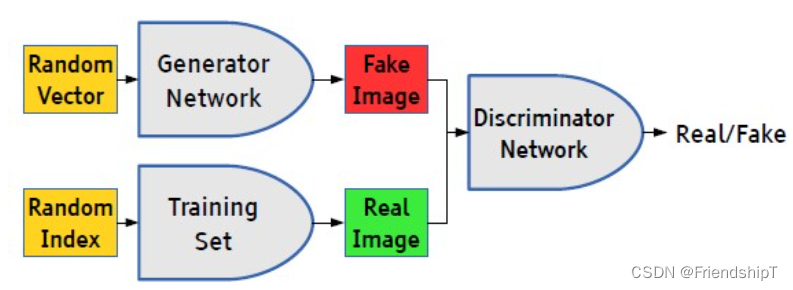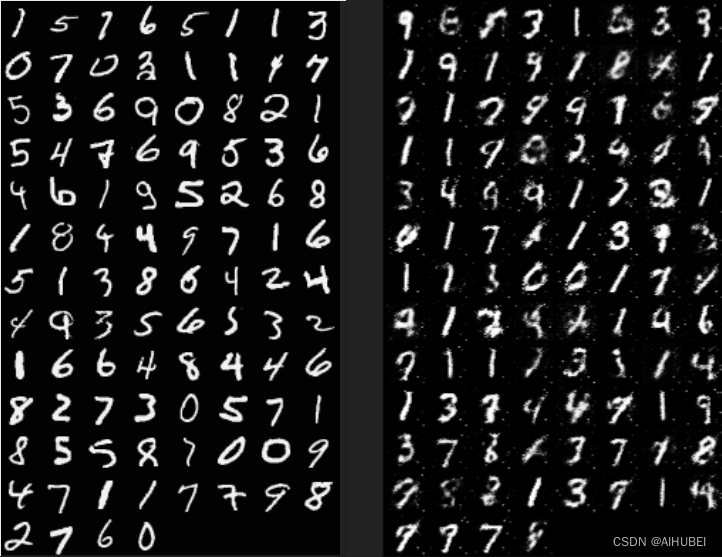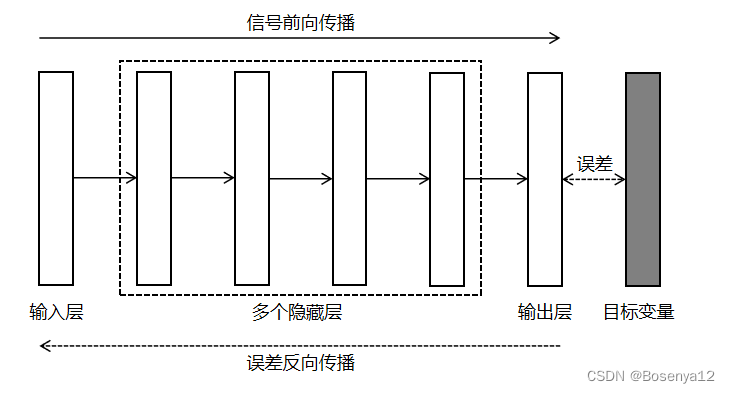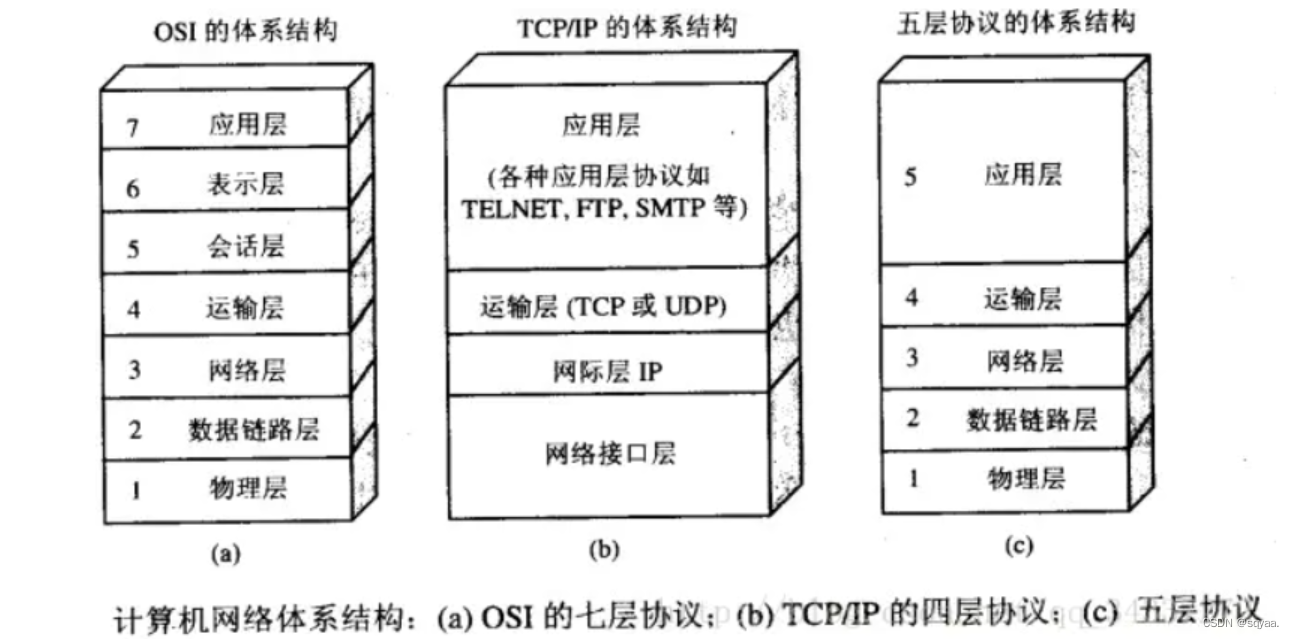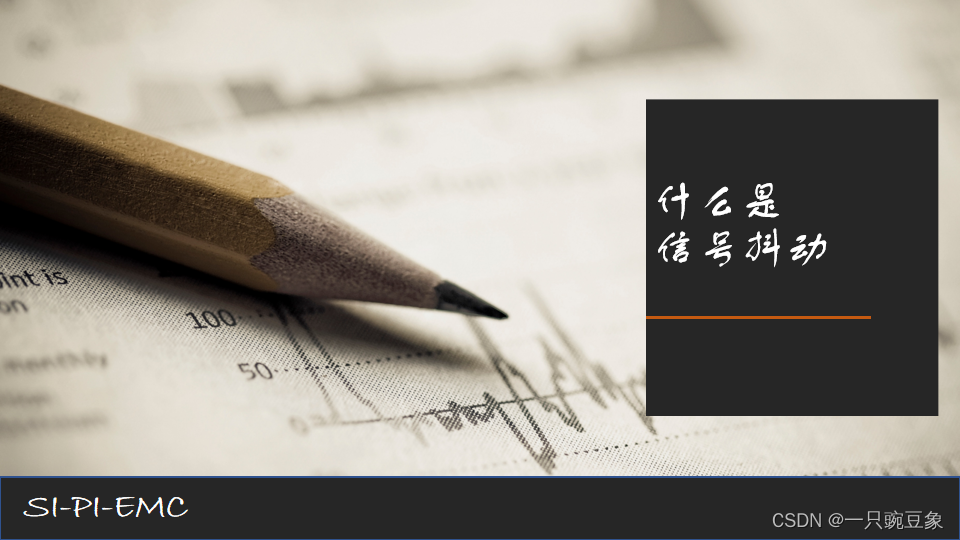1 概述
what:给定一句话,或一些要求,按要求生成需要的图像。
本篇总结主要包含反卷积和GAN(generative adversial network, GAN)
2 反卷积与图像生成
what:反卷积可以看成卷积的反操作,但不完全一样,不是把卷积反过来就是反卷积。即给定特征,反向生成输入。但反卷积运算的卷积核与卷积运算的不同
效果:卷积是大图像越来越小,反卷积可以图像越来越大
2.1 反卷积运算
卷积核不同:卷积卷积核旋转180度可得到反卷积运算的卷积核
padding:如果希望反卷积运算后,图像大小保持不变,需要计算padding并给输入图像补padding
2.2 反池化运算
反池化有很多方法,有一种卷积运算方法可以近似省略池化(因为效果相近),即给卷积运算加步伐。即每一个卷积核在原图像运算完,朝下一个运算窗口移动的步数。默认步数是1.步数大于1的效果很接近卷积+池化运算效果。这样的卷积运算,可以看成步数为1的卷积运算+池化运算,即省略了池化运算
步伐>2的卷积效果:卷积得到的图像比步伐小的图像更小。因此反卷积时,也需要处理此种情况
2.3 反卷积和分数步伐
步伐>2的卷积,可以通过分数步伐的反卷积恢复。即对输入图像每个像素点之间补充空白点,卷积步长越大,反卷积补的像素间空白点就越多
2.4 批正则化技术
概念:是每一层神经网络层和非线性运算层之间加入的一个线性运算层,逻辑为y=ax+b。a,b为要学习的参数,x为一批里归一化处理后的输入:(x-mean(x))/std
3 图像生成-最小均方差模型
3.1 思路
输入是一个数字,输出是一个数字的手写图像。通过反卷积网络实现这样的输入与输出
3.2 代码实现
import torch
import torch.nn as nn
import torch.optim as optim
import torch.nn.functional as F
import torchvision.datasets as datasets
import torchvision.transforms as transforms
import torchvision.utils as util
import matplotlib.pyplot as pyplot
import numpy as np
import os
output_img_size = 28
input_dim = 100
channel_num = 1
features_num = 64
batch_size = 64
print(f'prepare datasets begin')
use_cuda = torch.cuda.is_available()
dtype = torch.cuda.FloatTensor if use_cuda else torch.FloatTensor
itype = torch.cuda.LongTensor if use_cuda else torch.LongTensor
train_dataset = datasets.MNIST(root='./data', train=True, transform=transforms.ToTensor(), download=True)
test_dataset = datasets.MNIST(root='./data', train=False, transform=transforms.ToTensor())
train_loader = torch.utils.data.DataLoader(dataset=train_dataset, batch_size=batch_size, shuffle=True)
index_verify = range(len(test_dataset))[:5000]
index_test = range(len(test_dataset))[5000:]
sampler_verify = torch.utils.data.sampler.SubsetRandomSampler(index_verify)
sampler_test = torch.utils.data.sampler.SubsetRandomSampler(index_test)
verify_loader = torch.utils.data.DataLoader(dataset=test_dataset, batch_size=batch_size, sampler=sampler_verify)
test_loader = torch.utils.data.DataLoader(dataset=test_dataset, batch_size=batch_size, sampler=sampler_test)
class AntiCNN(nn.Module):
def __init__(self):
super(AntiCNN, self).__init__()
self.model = nn.Sequential()
self.model.add_module('deconv1', nn.ConvTranspose2d(input_dim, features_num * 2, 5, 2, 0, bias=False))
self.model.add_module('batch_norm1', nn.BatchNorm2d(features_num * 2))
self.model.add_module('relu1', nn.ReLU(True))
self.model.add_module('deconv2', nn.ConvTranspose2d(features_num * 2, features_num, 5, 2, 0, bias=False))
self.model.add_module('batch_norm2', nn.BatchNorm2d(features_num))
self.model.add_module('relu2', nn.ReLU(True))
self.model.add_module('deconv3', nn.ConvTranspose2d(features_num, channel_num, 4, 2, 0, bias=False))
self.model.add_module('sigmoid', nn.Sigmoid())
def forward(self, input):
output = input
for _, module in self.model.named_children():
output = module(output)
return output
def weight_init(module):
class_name = module.__class__.__name__
if class_name.find('conv') != -1:
module.weight.data.normal_(0, 0.02) # convey mean and std
if class_name.find('norm') != -1:
module.weight.data.normal_(1, 0.02)
def resize_to_img(img):
return img.data.expand(batch_size, 3, output_img_size, output_img_size)
def imgshow(input, title=None):
if input.size()[0] > 1:
input = input.numpy().transpose((1, 2, 0))
else:
input = input[0].numpy()
min_val, max_val = np.amin(input), np.amax(input)
if max_val > min_val:
input = (input - min_val) / (max_val - min_val)
pyplot.imshow(input)
if title:
pyplot.title(title)
pyplot.pause(0.001)
def main():
net = AntiCNN()
net = net.cuda() if use_cuda else net
criterion = nn.MSELoss()
optimizer = optim.SGD(net.parameters(), lr=0.0001, momentum=0.9)
samples = np.random.choice(10, batch_size)
samples = torch.from_numpy(samples).type(dtype)
step = 0
num_epoch = 2
record = []
print('train begin')
for epoch in range(num_epoch):
print(f'the no.{epoch} epoch')
train_loss = []
for batch_index, (data, target) in enumerate(train_loader):
target, data = data.clone().detach().requires_grad_(True), target.clone().detach()
#target, data = target.cuda(), data.cuda() if use_cuda else target, data
if use_cuda:
target, data = target.cuda(), data.cuda()
data = data.type(dtype)
data = data.resize(data.size()[0], 1, 1, 1)
data = data.expand(data.size()[0], input_dim, 1, 1)
net.train()
output = net(data)
loss = criterion(output, target)
optimizer.zero_grad()
loss.backward()
optimizer.step()
step += 1
loss = loss.cpu() if use_cuda else loss
train_loss.append(loss.data.numpy())
if batch_index % 300 == 0:
net.eval()
verify_loss = []
index = 0
for data, target in verify_loader:
target, data = data.clone().detach().requires_grad_(True), target.clone().detach()
index += 1
# target, data = target.cuda(), data.cuda() if use_cuda else target, data
if use_cuda:
target, data = target.cuda(), data.cuda()
data = data.type(dtype)
data = data.resize(data.size()[0], 1, 1, 1)
data = data.expand(data.size()[0], input_dim, 1, 1)
output = net(data)
loss = criterion(output, target)
loss = loss.cpu() if use_cuda else loss
verify_loss.append(loss.data.numpy())
print(f'now no.{batch_index} batch. train loss:{np.mean(train_loss):.4f}, verify loss:{np.mean(verify_loss):.4f}')
record.append([np.mean(train_loss), np.mean(verify_loss)])
with torch.no_grad():
samples.resize_(batch_size, 1, 1, 1)
samples = samples.data.expand(batch_size, input_dim, 1, 1)
# samples = samples.cuda() if use_cuda else samples
if use_cuda:
samples = samples.cuda()
fake_u = net(samples)
# fake_u = fake_u.cuda() if use_cuda else fake_u
if use_cuda:
fake_u = fake_u.cuda()
img = resize_to_img(fake_u)
os.makedirs(os.path.realpath('./pytorch/jizhi/image_generate/temp1'), exist_ok=True)
util.save_image(img, os.path.realpath(f'./pytorch/jizhi/image_generate/temp1/fake{epoch}.png'))
pyplot.show()
if __name__ == '__main__':
main()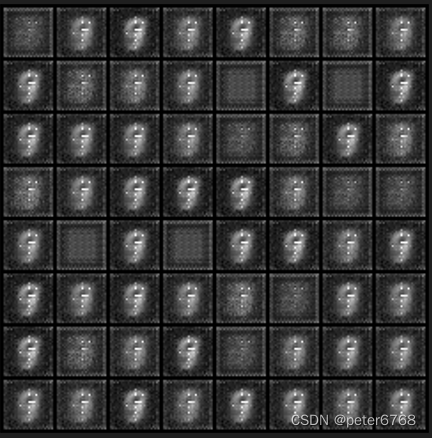
发现图片很模糊,可能是均方误差算的是所有手写数字的平均值,且每个图像没有明显模式,倒是平均值就是很模糊。咋整呢?可以尝试用之前的手写数字图像识别器帮助矫正MSE

